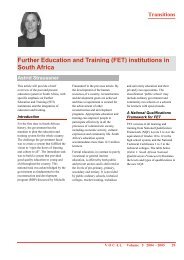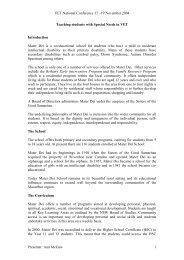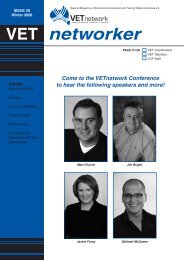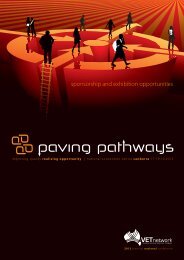QSA Self-Assessment Tool for TAA40104 Certificate IV in Training ...
QSA Self-Assessment Tool for TAA40104 Certificate IV in Training ...
QSA Self-Assessment Tool for TAA40104 Certificate IV in Training ...
- No tags were found...
You also want an ePaper? Increase the reach of your titles
YUMPU automatically turns print PDFs into web optimized ePapers that Google loves.
<strong>QSA</strong> <strong>Self</strong>-<strong>Assessment</strong> <strong>Tool</strong><strong>for</strong><strong>TAA40104</strong> <strong>Certificate</strong> <strong>IV</strong><strong>in</strong> Tra<strong>in</strong><strong>in</strong>g and <strong>Assessment</strong>This self-assessment tool has been developed to assist Queensland school teachers to demonstrateequivalence to <strong>TAA40104</strong> <strong>Certificate</strong> <strong>IV</strong> <strong>in</strong> Tra<strong>in</strong><strong>in</strong>g and <strong>Assessment</strong> <strong>for</strong> VET delivered and assessedunder the <strong>QSA</strong>’s delegation from the Tra<strong>in</strong><strong>in</strong>g and Employment Recognition Council.This booklet conta<strong>in</strong>s the follow<strong>in</strong>g:General <strong>in</strong><strong>for</strong>mationPart A Instructions <strong>for</strong> us<strong>in</strong>g the <strong>QSA</strong> self-assessment toolPart B Structure of <strong>TAA40104</strong> <strong>Certificate</strong> <strong>IV</strong> <strong>in</strong> Tra<strong>in</strong><strong>in</strong>g and <strong>Assessment</strong>Part C Overview of evidence required to demonstrate equivalenceEvidence-gather<strong>in</strong>g toolsPart D Evidence-gather<strong>in</strong>g log bookPart E Statement of ‘equivalence’ to <strong>TAA40104</strong> <strong>Certificate</strong> <strong>IV</strong> <strong>in</strong> Tra<strong>in</strong><strong>in</strong>g and <strong>Assessment</strong>Teacher’s name.Part A — Instructions <strong>for</strong> us<strong>in</strong>g the <strong>QSA</strong> self-assessment tool todemonstrate equivalence to <strong>TAA40104</strong> <strong>Certificate</strong> <strong>IV</strong> <strong>in</strong> Tra<strong>in</strong><strong>in</strong>g and<strong>Assessment</strong>
Meet<strong>in</strong>g AQTF standard 7.3/7.4To satisfy Standard 7.3 & 7.4 of the Australian Quality Tra<strong>in</strong><strong>in</strong>g Framework Standards <strong>for</strong>Registered Tra<strong>in</strong><strong>in</strong>g Organisations (2005), staff <strong>in</strong>volved <strong>in</strong> tra<strong>in</strong><strong>in</strong>g and assessment <strong>in</strong> VETmust have one of the follow<strong>in</strong>g:• BSZ40198 <strong>Certificate</strong> <strong>IV</strong> <strong>in</strong> <strong>Assessment</strong> and Workplace Tra<strong>in</strong><strong>in</strong>g or• Demonstrated equivalence to BSZ40198 <strong>Certificate</strong> <strong>IV</strong> <strong>in</strong> <strong>Assessment</strong> and WorkplaceTra<strong>in</strong><strong>in</strong>g prior to 23 November 2005 or• <strong>TAA40104</strong> <strong>Certificate</strong> <strong>IV</strong> <strong>in</strong> Tra<strong>in</strong><strong>in</strong>g and <strong>Assessment</strong> or• Demonstrated equivalence to <strong>TAA40104</strong> <strong>Certificate</strong> <strong>IV</strong> <strong>in</strong> Tra<strong>in</strong><strong>in</strong>g and <strong>Assessment</strong>.Who needs to use this tool?This tool has been developed to help teachers <strong>in</strong> Queensland schools who need todemonstrate equivalence to <strong>TAA40104</strong> <strong>Certificate</strong> <strong>IV</strong> <strong>in</strong> Tra<strong>in</strong><strong>in</strong>g and <strong>Assessment</strong>. Teacherswho would need to use this tool could <strong>in</strong>clude:• teachers who commence VET delivery and assessment <strong>for</strong> the first time after 23November 2005, <strong>for</strong> example first-year teachers or experienced teachers who have neverdelivered and assessed vocational education and tra<strong>in</strong><strong>in</strong>g• VET teachers who have not demonstrated equivalence to BSZ40198 and will be deliver<strong>in</strong>gand assess<strong>in</strong>g VET after 23 November 2005, <strong>for</strong> example a return<strong>in</strong>g teacher.MentorAQTF Standard 7.3/7.4 states that if a teacher does not have the assessor units ofcompetency (TAAASS401A, TAAASS402A and TAAASS404A) or cannot demonstrateequivalence, then the teacher must work with someone who does meet the requirement toconduct VET assessment. In addition, if a teacher does not have <strong>TAA40104</strong> or cannotdemonstrate equivalence, then the teacher must work under the direct supervision of a personwho does meet the requirement to deliver VET. It is envisaged that a teacher would needto work with a mentor <strong>for</strong> at least 12 months to enable the teacher to develop andcollect the evidence required to demonstrate equivalence.How to complete the tool?1. Read the summary details of the units of competency and elements of competency <strong>in</strong> PartB. The units of competency should be downloaded from www.ntis.gov.au, or the tra<strong>in</strong><strong>in</strong>gpackage purchased.2. Refer to the ‘Overview of evidence required to demonstrate equivalence’ (Part C) whichillustrates the relationship of the evidence to be gathered <strong>in</strong> the ‘Evidence-gather<strong>in</strong>g logbook’ (Part D) and ‘Statement of equivalence to <strong>TAA40104</strong>’ (Part E), to the units ofcompetency.3. Record <strong>in</strong> the ‘Evidence-gather<strong>in</strong>g log book’ (Part D) the evidence collected which hasbeen presented <strong>for</strong> exam<strong>in</strong>ation to a person who meets the requirements of AQTFstandards 7.3/7.4 (e.g. mentor).4. The ‘Evidence-gather<strong>in</strong>g log book’ (Part D) should be updated regularly by the teacherand the mentor as they work together throughout the year.5. When all evidence has been presented, and ‘equivalence’ to <strong>TAA40104</strong> established,complete ‘Statement of equivalence to <strong>TAA40104</strong> <strong>Certificate</strong> <strong>IV</strong> <strong>in</strong> Tra<strong>in</strong><strong>in</strong>g and<strong>Assessment</strong>‘ (Part E).6. A copy of this booklet must be attached to the teacher’s staff profile, and be presented at<strong>in</strong>ternal reviews, <strong>in</strong>ternal audits and external audits.7. If the teacher moves from one school to another be<strong>for</strong>e this document is completed• the teacher should request sign-off of all possible parts of the Mentor Checklist; andon arrival at the new school, the teacher should request the appo<strong>in</strong>tment of a mentor to cont<strong>in</strong>ue
the process.Part B – Structure of <strong>TAA40104</strong> <strong>Certificate</strong> <strong>IV</strong> <strong>in</strong> Tra<strong>in</strong><strong>in</strong>g and<strong>Assessment</strong> recommended by Queensland Studies Authority•nits of competency lement of competencyAAENV401A Work effectively <strong>in</strong>vocational education andtra<strong>in</strong><strong>in</strong>gAAENV402A Foster and promotean <strong>in</strong>clusive learn<strong>in</strong>g cultureAAENV403A Ensure a healthyand safe learn<strong>in</strong>g environmentAADES401A Use Tra<strong>in</strong><strong>in</strong>gPackages to meet client needsAADES402A Design and developlearn<strong>in</strong>g programsAADEL401A Plan and organisegroup-based deliveryAADEL403A Facilitate <strong>in</strong>dividuallearn<strong>in</strong>gAADEL404A Facilitate workbasedlearn<strong>in</strong>gAAASS401A Plan and organiseassessmentAAASS402A Assess competenceAAASS403A Develop assessmenttoolsAAASS404A Participate <strong>in</strong>assessment validationAADEL402A Facilitate groupbasedlearn<strong>in</strong>g1. Work with<strong>in</strong> the vocational education and tra<strong>in</strong><strong>in</strong>g policy framework2. Work with<strong>in</strong> the tra<strong>in</strong><strong>in</strong>g and/or assessment organisation’s quality framework3. Manage work and work relationships4. Demonstrate a client-focused approach to work1. Practise <strong>in</strong>clusivity2. Promote and respond to diversity3. Develop and implement work strategies to support <strong>in</strong>clusivity4. Promote a culture of learn<strong>in</strong>g5. Monitor and improve work practice1. Identify OHS responsibilities2. Identify hazards <strong>in</strong> the learn<strong>in</strong>g environment3. Assess risk <strong>in</strong> the learn<strong>in</strong>g environment4. Develop and implement actions to ensure the health safety and welfare of learnersand/or candidates5. Provide appropriate OHS requirements to learners and/or candidates6. Monitor OHS arrangements <strong>in</strong> the learn<strong>in</strong>g environment1. Def<strong>in</strong>e the basis <strong>for</strong> us<strong>in</strong>g Tra<strong>in</strong><strong>in</strong>g Package/s and accredited courses2. Analyse and <strong>in</strong>terpret the qualifications framework3. Analyse and <strong>in</strong>terpret competency standards and accredited modules <strong>for</strong> clientapplication/s4. Contextualise competency standards and accredited courses <strong>for</strong> clientapplication/s5. Analyse and <strong>in</strong>terpret assessment guidance <strong>for</strong> client application6. Use Tra<strong>in</strong><strong>in</strong>g Package/s and accredited course as an <strong>in</strong>tegrated tool <strong>for</strong> clientapplication1. Def<strong>in</strong>e the parameters of the learn<strong>in</strong>g program <strong>in</strong> consultation with the client/s2. Generate options <strong>for</strong> design<strong>in</strong>g the learn<strong>in</strong>g program3. Develop the learn<strong>in</strong>g program content4. Design the structure of the learn<strong>in</strong>g program5. Review the learn<strong>in</strong>g program1. Interpret the learn<strong>in</strong>g environment and delivery requirements2. Prepare session plans3. Prepare resources needed <strong>for</strong> delivery1. Identify <strong>in</strong>dividual learn<strong>in</strong>g facilitation requirements2. Establish the learn<strong>in</strong>g/facilitation relationship3. Ma<strong>in</strong>ta<strong>in</strong> and develop the learn<strong>in</strong>g/facilitation relationship4. Close and evaluate the learn<strong>in</strong>g/facilitation relationship1. Establish an effective work environment <strong>for</strong> learn<strong>in</strong>g2. Develop a work-based learn<strong>in</strong>g pathway3. Implement the work-based learn<strong>in</strong>g pathway4. Monitor learn<strong>in</strong>g and address barriers to effective participation5. Review the effectiveness of the work-based learn<strong>in</strong>g pathway1. Determ<strong>in</strong>e focus of assessment2. Prepare the assessment plan3. Contextualise and review assessment plan4. Organise assessment arrangements1. Establish and ma<strong>in</strong>ta<strong>in</strong> the assessment environment2. Gather quality evidence3. Support the candidate4. Make the assessment decision5. Record and report the assessment decision6. Review the assessment process1. Determ<strong>in</strong>e the focus of the assessment tool2. Determ<strong>in</strong>e assessment tool needs3. Design and develop assessment tools4. Review and trial assessment tools1. Prepare <strong>for</strong> validation2. Contribute to validation process3. Contribute to validation outcomes1. Establish an environment conducive to group learn<strong>in</strong>g2. Deliver and facilitate tra<strong>in</strong><strong>in</strong>g sessions3. Demonstrate effective facilitation skills4. Support and monitor learn<strong>in</strong>g
AADEL301A Provide tra<strong>in</strong><strong>in</strong>gthrough <strong>in</strong>struction anddemonstration of work skills5. Review and evaluate effectiveness of delivery1. Organise <strong>in</strong>struction and demonstration2. Conduct <strong>in</strong>struction and demonstration3. Check tra<strong>in</strong><strong>in</strong>g per<strong>for</strong>mancePart C – Overview of evidence required to demonstrate equivalence<strong>QSA</strong> staff undertook an <strong>in</strong>-depth analysis of the units of competency <strong>in</strong> <strong>TAA40104</strong> <strong>Certificate</strong> <strong>IV</strong><strong>in</strong> Tra<strong>in</strong><strong>in</strong>g and <strong>Assessment</strong>, and the evidence teachers could provide to support ‘equivalence’ to<strong>TAA40104</strong>. The evidence will be gathered through the ‘Evidence gather<strong>in</strong>g log book’ (PartD) and ‘Statement of equivalence to <strong>TAA40104</strong>’ (Part E). The follow<strong>in</strong>g table needs to beread <strong>in</strong> conjunction with Parts D and E.nits of CompetencyAorevidence is <strong>in</strong>dicated by theTAAENV401A Work Effectively <strong>in</strong> vocational education and tra<strong>in</strong><strong>in</strong>gTAAENV402A Foster and promote an <strong>in</strong>clusive learn<strong>in</strong>g cultureTAAENV403A Ensure a healthy and safe learn<strong>in</strong>g environmentTAADES401A Use Tra<strong>in</strong><strong>in</strong>g Packages to meet client needsTAADES402A Design and Develop learn<strong>in</strong>g programsTAADEL401A Plan and organise group-based delivery (teacher meets requirement)TAADEL403A Facilitate <strong>in</strong>dividual learn<strong>in</strong>gTAADEL404A Facilitate work-based learn<strong>in</strong>gTAAASS401A Plan and organise assessmentTAAASS402A Assess competenceTAAASS403A Develop assessment toolsTAAASS404A Participate <strong>in</strong> assessment validationlectives (teacher meets requirement <strong>for</strong> follow<strong>in</strong>g units)TAADEL402A Facilitate group-based learn<strong>in</strong>gTAADEL301A Provide tra<strong>in</strong><strong>in</strong>g through <strong>in</strong>struction and demonstration of work skillsKey:Evidence-gather<strong>in</strong>g techniquesA – Teach<strong>in</strong>g qualification– Learn<strong>in</strong>g and <strong>Assessment</strong> Strategy/<strong>in</strong>dividual learn<strong>in</strong>g plans– Competency-based assessment <strong>in</strong>struments– M<strong>in</strong>utes of attended meet<strong>in</strong>gs, e.g. VET, learn<strong>in</strong>g support, OHS– Adherence to school’s policy documents – general, AQTF– Teach<strong>in</strong>g/practicum experience, VET qualification, work history, professionaldevelopment, e.g. staff profile with verified copies of qualificationsG – VET Induction (checklist/attendance/agen– Internal Review/ Internal Audit/ <strong>in</strong>dustry vactivities (evidence of participation)– Student VET profiles, student assessmen– Analysis of stakeholder feedback/self-evaK – Demonstration of relevant underp<strong>in</strong>n<strong>in</strong>g k– Documented evidence of mentor<strong>in</strong>g arranprocedure, <strong>in</strong>-service sessions, <strong>for</strong>mal/<strong>in</strong>foPart D – Evidence-gather<strong>in</strong>g log bookThis ‘Evidence-gather<strong>in</strong>g log book’ should be signed off by the mentor/s only when the teacher hasshown consistency <strong>in</strong> the activity or production of the evidence shown below.Focus Activity/evidence Refer toPart EAccessed AQTF Standards / Evidence GuideReferred to/is familiar with school Quality ManualDateMentor<strong>in</strong>itials
Referred to/is familiar with school VET Teacher’s ManualAccessed DOEM or similar <strong>for</strong> WHS, Risk assessment andother relevant policiesAttended VET meet<strong>in</strong>gs/workshops Item 8Adheres to school general and VET policy & proceduresCompleted school general Teacher <strong>in</strong>ductionCompleted school VET Teacher Induction Item 10Accessed relevant Tra<strong>in</strong><strong>in</strong>g PackageAccessed copies of relevant sections of Tra<strong>in</strong><strong>in</strong>g PackageAccessed relevant competencies <strong>in</strong> Tra<strong>in</strong><strong>in</strong>g PackageReferred to Range Statements <strong>in</strong> competenciesContextualised learn<strong>in</strong>g experiences <strong>for</strong> studentsProduced Learn<strong>in</strong>g and <strong>Assessment</strong> Strategy documents toensure cultural <strong>in</strong>clusivity and the diversity of studentbackgrounds – two versions of same qualification or fromdifferent qualificationProduced <strong>in</strong>dividual learn<strong>in</strong>g plans <strong>for</strong> students with specialneeds (more than one plan, different students)Participated <strong>in</strong> provid<strong>in</strong>g one-on-one mentor<strong>in</strong>g with<strong>in</strong>dividual students outside of class time with more than onestudent on more than one occasionCurrently teach<strong>in</strong>g VET (competency-based tra<strong>in</strong><strong>in</strong>g andassessment) class/esWork history of deliver<strong>in</strong>g and assess<strong>in</strong>g VET (Practicum,previous VET teach<strong>in</strong>g)Facilitated student learn<strong>in</strong>g <strong>in</strong> the workplace or a simulatedworkplaceItem 2Items3(a) (b)Item 11Item 9Participated <strong>in</strong> teacher workplace currency activities Item 9Produced assessment items that satisfy AQTF standard 8 &the rules of evidence, <strong>for</strong> at least three units of competencyProduced expected student responses to assessment itemsMapped elements of competency to assessment itemsModified assessment items <strong>for</strong> special needs studentsMet with support staffItem 4(a)Item 4(a)Item 4(a)Item 4(b)Analysed stakeholder feedback Item 6Item4(c)Item4(c)
Item4(c)Item4(c)Item 5Item 5Item 5Item 5Designed student assessment profiles Item 7Completed student assessment profile Item 7Details of mentor/sMentor 1:Name:Position:Mentor 2:Name:Position:Comments:
Part E – Statement of equivalence to <strong>TAA40104</strong> <strong>Certificate</strong> <strong>IV</strong> <strong>in</strong> Tra<strong>in</strong><strong>in</strong>gand <strong>Assessment</strong>Teacher’s nameThe follow<strong>in</strong>g collection of evidence, that contributes to demonstart<strong>in</strong>g equivalence to <strong>TAA40104</strong>,has been presented by the teacher named above, and exam<strong>in</strong>ed by the teacher’s mentor/s whomeet/s the requirements of AQTF standards 7.3/7.4.1. teach<strong>in</strong>g qualification and, if applicable, other relevant qualifications2. two Learn<strong>in</strong>g and <strong>Assessment</strong> Strategy documents3. examples of facilitat<strong>in</strong>g <strong>in</strong>dividual learn<strong>in</strong>g with two different students, e.g. mentor<strong>in</strong>g,coach<strong>in</strong>g, tutor<strong>in</strong>ga. <strong>in</strong>dividual student learn<strong>in</strong>g plansb. self-evaluation and student feedback <strong>in</strong> regard to meet<strong>in</strong>g goals4. <strong>for</strong> three units of competencyc. competency-based assessment items (with mark<strong>in</strong>g schemes/suggestedresponses/suggested actions) cover<strong>in</strong>g a range of assessment methods andeach item clearly mapped to the units of competencyd. some items customised to show reasonable adjustmente. review/validation documentation5. participation <strong>in</strong> <strong>in</strong>ternal reviews and/or <strong>in</strong>ternal audits and/or other <strong>in</strong>dustry validationactivities, and <strong>in</strong>ternal moderation activities6. analysis of stakeholder feedback/self-evaluation7. student VET profiles and student assessment folios8. m<strong>in</strong>utes of relevant meet<strong>in</strong>gs attended9. detailed staff profile10. VET Induction checklist/agenda11. teacher timetable show<strong>in</strong>g VET classes•SchoolPr<strong>in</strong>cipal’s namePr<strong>in</strong>cipal’s signatureDate














